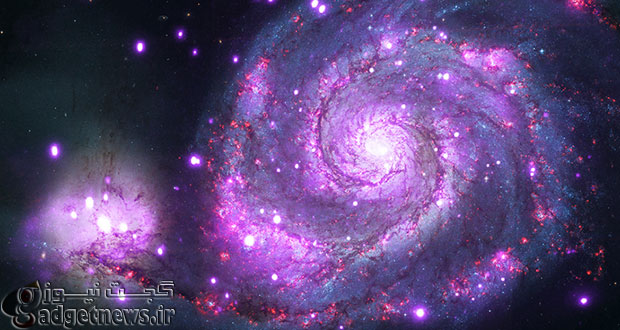ستارهشناسان تلسکوپ فضایی پرتو ایکس چاندرا ناسا در کاوشهای کیهانی خود توانست کهکشان مسیه ۵۱ (M51) با نام مستعار «کهکشان گرداب» را در بهترین زاویه رصد کنند.
تصاویر ارسالی تلسکوپ ناسا که حاصل بیش از ۲۵۰ ساعت جستوجوی فضایی است، ۵۰۰ منبع اشعه ایکس را در اطراف کهکشان مسیه ۵۱ شکار کرد. نورهای بنفش رنگ در این کهکشان نتیجه پرتوهای ایکس دوگانه، ستارگان نوترونی، سیاهچالهها و انفجارهایی بوده که میلیونها سال پیش اتفاق افتاده است.
کهکشان گرداب که NGC 5194 نیز نامیده می شود، در واقع یک کهکشان مارپیچی کلاسیک است که در فاصله ایی تنها برابر ۳۰ میلیون سال نوری و با ۶۰ هزار سال نوری گستردگی، یکی از پرنورترین و زیباترین کهکشان ها در آسمان است. ۱۰ رشته از پرتوهای دوگانه اشعه ایکس در کهکشان گرداب بسیار درخشانتر به نظر میرسند و ستارهشناسان ناسا معتقدند این پرتوها به همراه ابر ستارگان اطراف، مقدمات پیدایش سیاهچالهها را فراهم خواهند آورد. تلسکوپ فضایی چاندرا، با طول ۱۴ متر و وزنی معادل ۲.۵ تن، ۱۵ سال پیش توسط شاتل فضایی کلمبیا به فضا پرتاب شد. این تلسکوپ یک میلیارد و ۶۵۰ میلیون دلاری تاکنون تصاویر فوقالعادهای از اجرام کیهانی به زمین مخابره کرده است.
منابع: universetoday | chandra
Amazing New X-Ray Image of the Whirlpool Galaxy
Amazing New X-Ray Image of the Whirlpool Galaxy
Amazing New X-Ray Image of the Whirlpool Galaxy Shows it is Dotted with Black Holes In any galaxy there are hundreds of X-ray binaries: systems consisting of a black hole capturing and heating material from a relatively low-mass orbiting companion star. But high-mass X-ray binaries — systems consisting of a black hole and an extremely high-mass companion star — are hard to come by. In the Milky Way there’s only one: Cygnus X-1. But 30 million light-years away in the Whirlpool galaxy, M51, there are a full 10 high-mass X-ray binaries. Nearly a million seconds of observing time with NASA’s Chandra X-ray Observatory has revealed these specks. “This is the deepest, high-resolution exposure of the full disk of any spiral galaxy that’s ever been taken in the X-ray,” said Roy Kilgard, from Wesleyan University, at a talk presented at the American Astronomical Society meeting today in Boston. “It’s a remarkably rich data set.” Within the image there are 450 X-ray points of light, 10 of which are likely X-ray binaries. The Whilpool galaxy is thought to have so many X-ray binaries because it’s in the process of colliding with a smaller companion galaxy. This interaction triggers waves of star formation, creating new stars at a rate seven times faster than the Milky Way and supernova deaths at a rate 10-100 times faster. The more-massive stars simply race through their evolution in a few million years and collapse to form neutron stars or black holes quickly. “In this image, there’s a very strong correlation between the fuzzy purple stuff, which is hot gas in the X-ray, and the fuzzy red stuff, which is hydrogen gas in the optical,” said Kilgard. “Both of these are tracing the star formation very actively. You can see it really enhanced in the northern arm that approaches the companion galaxy.” Eight of the 10 X-ray binaries are located close to star forming regions. Chandra is providing astronomers with an in depth look at a class of objects that has only one example in the Milky Way. “We’re catching them at a short window in their evolutionary cycle,” said Kilgard. “The massive star that formed the black hole has died, and the massive star that is accreting material onto the black hole has not yet died. The window at which these objects are X-ray bright is really short. It’s maybe only tens of thousands of years.”
 گجت نیوز آخرین اخبار تکنولوژی، علم و خودرو
گجت نیوز آخرین اخبار تکنولوژی، علم و خودرو 









